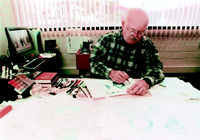
By the time John T. Houlihan, a 1966 Notre Dame graduate, joined Timex Corporation in 1979 as manager of design for digital products, he’d already put his stamp on some memorable products.
After studying automobile design at Notre Dame, he was hired by General Motors and played a key role in the Chevy Vega station wagon. As he recalls with some pride, the miniature car’s styling was “pretty cool” for its day.
One would be remiss, however, in not mentioning that Tom and Ray Magliozzi of National Public Radio’s Car Talk earlier this year named the Vega the second-worst car of the millennium, trailing only the Yugo. Of the Vega, one of the show’s listeners said, “As near as I could tell, the car was built from compressed rust.” The response from Houlihan, who owned one, is, “It seriously deserves its ranking.”
After the Vega wagon, Houlihan had a hand in designing the futuristic ’71 Buick Riviera “Boattail,” which had a distinctively contoured rear-window that came to a point. It sold like hot chocolate in July.
He later joined Smith-Corona and designed, among other things, some of the last adding machines made by the company before electronic calculators made them obsolete.
There were successes too, of course. But Houlihan’s greatest triumph didn’t come until a few years after he joined Timex, headquartered in Connecticut.
In the early 1980s, when Hawaii’s grueling swim-bike-run Ironman Triathlon first gained national attention, the company decided to design a watch specifically for serious athletes. Timex listened to athletes’ complaints about existing sports watches — buttons on the sides that were hard to operate while running, stop-watches that couldn’t store times — and added top-mounted push-buttons and a timer with a multilap memory, useful in comparing mile splits over long distances. The result was the Timex Triathlon, designed under Houlihan’s supervision. It was a success, Houlihan recalls, but it didn’t look all that different from countless other black chronographs. He decided to design something more stylish.
For starters, he wanted a metallic look. But he knew metal would be awfully heavy over marathon distances. And metallic paint would chip off of plastic in heavy use.
“I was pondering this one afternoon and looking at a BMW in the parking lot,” he recalls, “and it dawned on me that car paint is pretty rugged. Why don’t we paint the case with car paint?”
Car paint it was, since replaced by a solid-color plastic formulated with flecks of metal. He crowned the watch with a distinctive screwed-down face cover that produced a hatch-like effect and added a ribbed band with an Ironman logo printed in orange on the black.
When the Ironman Triathlon reached display cases, its form clearly reflected its intended function as a piece of rugged athletic equipment. What no one understood was how many people want to look athletic, even if the image extends no further than their wrist.
“When [the Ironman Triathlon] came out it absolutely took off like a rocket,” Houlihan says. “It sold hundreds of thousands in the first year and millions and millions since. It was the largest-selling single watch style in the world for a long time. It could even still be.”
Houlihan, now the company’s director of industrial design, says that to him designing products like cars, typewriters and watches is little different from creating fine-art sculpture. With products that have been around a long time, there’s not much room left for functional innovation. Styling becomes a priority. Just look at the success of the candy-colored iMacs of Apple Computer.
“When all other things are equal — the functions, the cost,” Houlihan says, “it’s the styling magic that makes the difference.”
— Ed Cohen